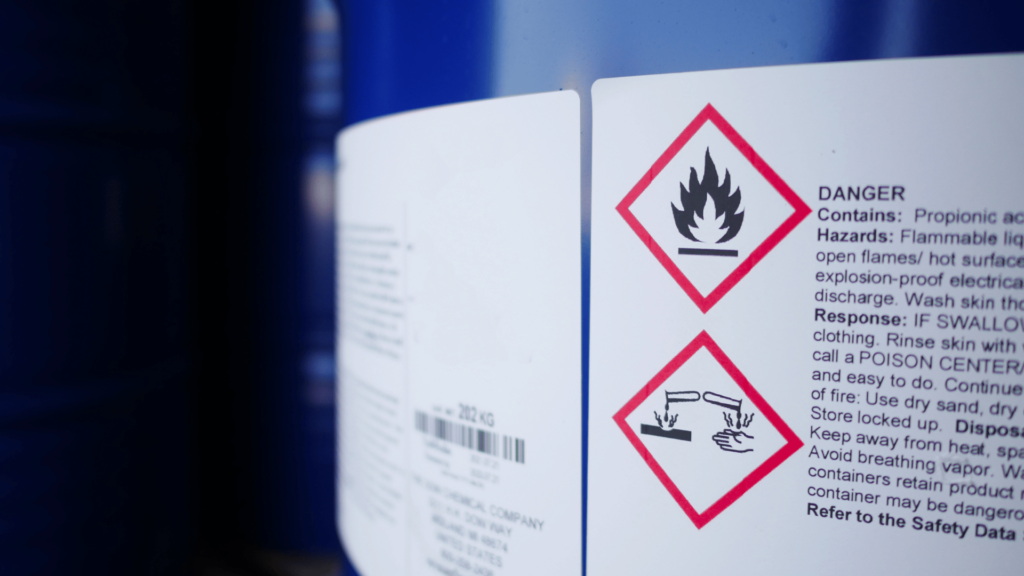If your labels are missing, you’re basically shipping chaos in a can
Imagine this: A truck flips on a highway, chemicals spill, a fire sparks, and emergency crews rush in, only to discover that nothing’s labeled. Now they’re guessing what’s burning. Gasoline? Acid? Unicorn tears? Welcome to a preventable disaster. This is why hazard communication isn’t just a suggestion, it’s a lifeline. Labels are more than stickers, they’re life-saving intel.
So what’s with all the colorful placards and scary icons? Let’s break it down
The DOT classifies hazardous materials into nine categories. And no, they’re not just for chemists and clipboard lovers. These classes are your cheat sheet to understanding what you’re dealing with.
Class 1: Explosives – Fireworks, TNT, stuff that literally goes boom.
Class 2: Gases – Compressed, liquefied, toxic, or flammable. From oxygen tanks to propane nightmares.
Class 3: Flammable Liquids – If it ignites under 141°F, it’s in. Hello, gasoline and paint.
Class 4: Flammable Solids – These bad boys can self-ignite or react with water. Metal powders are on the guest list.
Class 5: Oxidizers and Peroxides – Like throwing gasoline on a bonfire. They make flames go extra.
Class 6: Toxic and Infectious Substances – The “handle with gloves and don’t breathe it” gang.
Class 7: Radioactive Materials – Glowing is not a good sign. Think uranium and medical isotopes.
Class 8: Corrosives – These melt metal and munch through skin. Acids and lye live here.
Class 9: Miscellaneous Hazards – The wildcard crew. Batteries, dry ice, and anything that doesn’t fit elsewhere but still screams danger.
If you’re shipping it, you better be labeling it correctly or risk a federal slap
The Hazardous Materials Transportation Act (HMTA) is the law of the land when it comes to getting hazardous cargo from point A to point B without triggering an environmental apocalypse.
- Shipper: It’s your job to pack it right, label it right, and classify it correctly. No guessing games.
- Carrier: You’re driving it? Then you’re also responsible for keeping those labels visible and legible through every mile and bump.
Placards and ID numbers are more than truck bling
- Placards: Diamond-shaped signs that scream “Warning! Danger!” to anyone with eyes. They go on all sides of the truck and must follow strict size and placement rules. No duct-taped signs here.
- ID Numbers: These four-digit codes tell emergency responders exactly what’s inside. Example: 1203 = gasoline. That’s not just a number, it’s the key to the right response.
Now let’s talk storage, because danger doesn’t clock out
You nailed the transport, but where are you keeping this stuff once it arrives? OSHA has thoughts. Big, heavily-regulated thoughts.
- Flammable Liquids: Store in approved containers. Cabinets must be fire-resistant and labeled. Outdoor limits apply. Basically, don’t just chuck it in the broom closet.
- LPGs (Liquified Petroleum Gases): These belong outside in containers with strict clearance from buildings. No sneaking tanks into your break room.
- Anhydrous Ammonia: Indoors? It needs low-pressure, refrigerated tanks. Outdoors? Reflective paint, spacing, and zero flammable neighbors.
Bottom line? Know your labels or risk total chaos
From spilled bleach to full-on chemical mayhem, the difference between safe and sorry is often a label. Whether you’re a handler, shipper, receiver, or just the poor soul unloading the truck, understanding hazard classes, placards, ID numbers, and storage rules is your armor. No more label roulette.
Before you master container rules, make sure you know what those GHS labels are actually saying
Don’t let a mysterious diamond-shaped label trip you up. If you’re still unsure what a flame icon versus an exploding bomb means, get into the Hazard Communication: GHS Labeling Requirements Training Course. Your emergency response team will thank you.
Expand your knowledge with our Hazard Communication: Container Labeling, Transportation, and Storage Training Course.
This course covers the must-know basics, but if you’re handling hazardous materials and want to avoid fines, flammable disasters, and federal side-eyes, dig deeper with the full Hazard Communication: Container Labeling, Transportation, and Storage Training Program.
References



